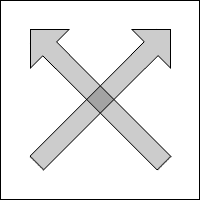There are many schools of thought on employee motivation. Here is the philosophy I’ve used while managing Internet software developers. The underlying principle is simple and has served me well.
Employee’s Goals

This graph represents your employee’s own personal goals. These are individual motivations which can be ideas like, “to get a promotion,” “to be a manager,” or even “to save enough to buy a house.” They don’t necessarily have to do with their day-to-day work either; they should be the deeply personal motivations which drive that person.
Company’s Goals

This graph represents your company’s goals. These can be company-wide or specific to your particular team. The key here is that an employee’s personal goals will rarely map directly with a company’s goals (you’re probably thinking, “no duh”).
The Convergence of Goals

At some point, there will be an overlapping of an employee’s personal goals and the company’s or team’s goals. If you can accurately identify both sets of goals, those that converge in the middle will be the strongest motivators for your employee within your business.
If your employee is working on a task that is outside his/her personal goals, but within the company’s/team’s goals, your employee will most probably still do it, but may not be strongly motivated, depending on how far it is from his/her personal goals. Conversely, if the task is outside the company’s goals, but within his/her personal goals, your employee will be strongly motivated, but the task won’t be of any use to your company.
It is also important to note that not every task can be mapped directly to an employee’s personal goals. Every job has its share of grunt work. But as long as a reasonable number of an employee’s tasks fall within the convergence of goals, then you’ll have a well-motivated employee.
An Example
Mary and Joseph are developers for Acme Software. David is their manager. Acme Software creates desktop and web widgets.
In his talks with Mary, David learns that her personal goals are to become a manager and one day own her own company. She’s already a brilliant developer who’s stronger in building web widgets than desktop widgets, but has lofty ambitions that span outside of Acme Software. Mary hasn’t yet held any managerial positions, but exhibits some leadership capabilities.
With Joseph, David learns that his personal goals are to purchase a bigger house for his growing family, get a promotion, and earn a name for himself in the open source community, where he already regularly contributes. He’s a strong desktop developer, but wants to grow his skills in web software. Joseph has no interest in management and the politics that come with it.
Joseph’s team is tasked with building a stock ticker widget for the desktop and the web. He needs a team lead, a senior developer for the desktop version, a senior developer for the web version, and junior developers for each.
Knowing what David knows, he gives Mary the assignment of being the team lead and Joseph the assignment of senior developer for the desktop version. This matches both of their personal goals and their team’s & company’s goals, with a few compromises. The rest of his team fills the other positions.
For Mary, this is a stretch role. David will have to mentor her closely as he tests her leadership and managerial aptitude. Her strong technical skills help her earn the respect of her team, though she will need help earning the respect of the product, sales, design, and QA teams. This experience will be very valuable for her, especially if she’s to own her own business one day. David explains this and Mary enthusiastically takes the assignment.
For Joseph, this is a stepping stone towards a promotion and internal recognition. As the senior developer in an area with which he is competent, desktop development, he will define the technical architecture while working closely with the senior developer for the web version. These discussions will familiarize him with web development and prepare him for a future role coding a web widget. David explains this and Joseph enthusiastically takes the assignment.
By understanding the convergence of his employees’ personal goals and the goals of his company & team, David has been able to staff a highly motivated team. Not all real life cases will be this easy, of course, but these underlying principles can be a useful guide for any manager.
One thought on “How to Motivate Employees”
Comments are closed.